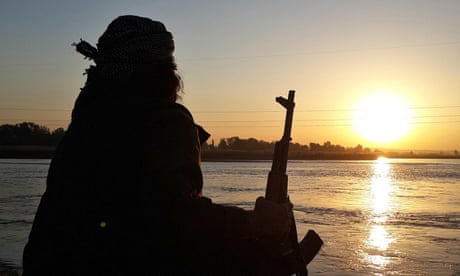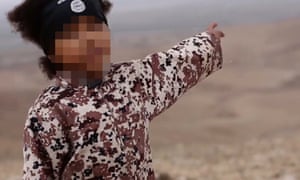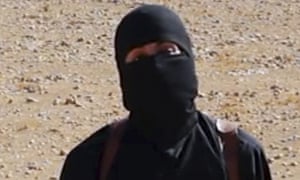Intelligence agencies investigate after video purportedly showing murder of five people is presented by British-sounding man and boy in military fatigues
Screengrab from a video purporting to be Isis showing a young boy making threats to kill. Photograph: Supplied
An extremist suspected to be British and a young English-speaking boy have appeared in a new Islamic State propaganda video that appears to show the murder of five hostages accused of being UK spies.
The 11-minute footage, which was released by the Isis media wing, includes a “message for David Cameron”, read by a masked man with a British-sounding accent who threatens attacks in the UK.

Why Isis fights
Standing behind five kneeling hostages in orange jumpsuits, the unknown extremist repeatedly points a gun at the camera while claiming to be preparing an invasion of Isis fighters in Europe.
The video then appears to show the murder of the hostages, who allegedly “confess” to having completed reconnaissance missions that were sanctioned by British authorities.
The clip, which has not been independently authenticated, concludes with footage of a young child in military-style fatigues, who warns in English: “We are going to go kill the kafir [non-believers] over there.”
In a seemingly deliberate emulation of Isis videos featuring the British extremistMohammed Emwazi, the footage focuses on one man wearing a balaclava and repeatedly addressing the prime minister directly.
FacebookTwitterPinterest Masked Isis jihadi with a British-sounding accent who threatens attacks in the UK in the name of Isis. Photograph: Supplied
Gesticulating in a manner similar to that used by Emwazi, who was also known as Jihadi John, the unnamed terrorist repeatedly waves a gun at the camera as he references British airstrikes in Syria.
On Sunday, UK security agencies began the hunt for what appears to be a Briton in the Isis video.
British investigators do not yet know the identity of the man taunting Cameron and making threats directed against the UK. They saw the video for the first time along with the rest of the world.
To establish the identity of the man wearing the balaclava, British investigators will have to rely on voice analysis and by monitoring chatter on Twitter and other social media, as well as other electronic communication, to search for clues.

Why has the AK-47 become the jihadi terrorist weapon of choice?
They might get lucky and establish his identity quickly, but the investigation is still at an early stage. It will probably be protracted – and is expected to take several months.
A Foreign Office spokesman said the video was “Daesh propaganda”, using another name for the terror group, and added that the government was examining its content.
An FCO source said it was likely Isis was trying to divert attention from “its recent military failings in Iraq and its inability to look after people in the areas that it controls”.
The pool of Britons fighting in Iraq and Syria is large. About 800 whose identities are known have gone to fight in Syria and Iraq, of whom 400 have returned to the UK. Between 50 and 100 Britons have died there, leaving about 300 still active.
Although it is possible his trip to the Middle East may have gone undetected, the suspected Briton is likely to be one of those 300.
Investigators have no way of authenticating the video but are working on the assumption that it is real. The man, in addition to delivering an anti-British tirade, gives the impression that he was also involved in the execution, but the footage may have been edited. He does not appear to have a regional or working-class accent.
The young boy in the video is not necessarily British and could easily be a Syrian or Iraqi who picked up some English.
The hostages, who are accused of being paid to gather information about Isis in Raqqa, Syria, are said to be aged between 25 and 40. The men are all labelled asmurtad in the footage – meaning apostate in Arabic. They appear to ask for forgiveness and call for Muslims to return to the faith.
Ubi Muhammad Abdul Ghani, 26, and Ha’il Marwan Abdul Razaq, 40, are both described as cameramen. Faisal Hamud al-Ja’far and Umaar Hamud al-Ja’far, both 25, as well as Mahyar Mahmud al-Uthmaan, 31, are named as the three remaining hostages, who appear to be shot dead by Isis extremists.
Ghani appears to say in Arabic translated by the Guardian that he had agreed to do covert camera work, such as taking videos and stills, in the city that is now an Isis stronghold. The video, he said, had been used by the BBC and other media. The BBC declined to comment.

Iraqi forces retake Ramadi from Isis - in pictures
British intelligence agencies never comment on whether someone is an agent. Their stock line is that they promised to protect the identity of agents and so never issue either a confirmation or a denial.
Charlie Winter, a senior researcher in transcultural conflict at Georgia State University in Atlanta, said: “Among other things, Isis is trying to seize the initiative again, having taken a major hit with the loss of Ramadi [in Iraq].”
He added that there had been an increase in propaganda videos and photo essays in recent weeks, designed to “divert attention away from big tactical blows like Ramadi”.
Winter added: “Leaving the executioner unnamed will cause an inevitable scramble, on the media’s part, to figure out who he is, thereby ensuring renewed prominence for Isis in the news.”
Regarding the appearance of an English-speaking child, the academic said: “There is, sadly, nothing strange about it – children are regularly used by Isis to execute alleged spies.”
Additional reporting by Fred McConnell







No comments:
Post a Comment